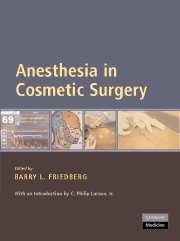Book contents
- Frontmatter
- Contents
- Foreword
- Acknowledgments
- Introduction
- Preface
- List of Contributors
- PART I MINIMALLY INVASIVE ANESTHESIA (MIA)Ⓡ FOR MINIMALLY INVASIVE SURGERY
- PART II ALTERNATIVE ANESTHESIA APPROACHES IN COSMETIC SURGERY
- 11 Intravenous Anesthesia for Cosmetic Surgery
- 12 Regional Anesthesia for Cosmetic Surgery
- 13 General Inhalation Anesthesia for Cosmetic Surgery
- PART III OTHER CONSIDERATIONS FOR ANESTHESIA IN COSMETIC SURGERY
- APPENDIX A A Guide to Perioperative Nutrition
- APPENDIX B Reflections on Thirty Years as an Expert Witness
- Index
- References
13 - General Inhalation Anesthesia for Cosmetic Surgery
from PART II - ALTERNATIVE ANESTHESIA APPROACHES IN COSMETIC SURGERY
Published online by Cambridge University Press: 22 August 2009
- Frontmatter
- Contents
- Foreword
- Acknowledgments
- Introduction
- Preface
- List of Contributors
- PART I MINIMALLY INVASIVE ANESTHESIA (MIA)Ⓡ FOR MINIMALLY INVASIVE SURGERY
- PART II ALTERNATIVE ANESTHESIA APPROACHES IN COSMETIC SURGERY
- 11 Intravenous Anesthesia for Cosmetic Surgery
- 12 Regional Anesthesia for Cosmetic Surgery
- 13 General Inhalation Anesthesia for Cosmetic Surgery
- PART III OTHER CONSIDERATIONS FOR ANESTHESIA IN COSMETIC SURGERY
- APPENDIX A A Guide to Perioperative Nutrition
- APPENDIX B Reflections on Thirty Years as an Expert Witness
- Index
- References
Summary
INTRODUCTION
The ultimate in consumer-driven medical care is the business of cosmetic surgery. These are purely elective procedures performed for the convenience and wishes of the buyer patient and at the convenience of the patient. Traditional ideology of surgical care is maximized as service is optimized. The maximization of service should never, however, compromise the prevailing medical, surgical, or anesthetic standard of care. Meeting the standard of care is the minimum requirement of the cosmetic surgical practice.
Much has been written regarding the safety of general anesthesia in the office. One should have a structure and plan for the administration of care that adheres to known standards. The care offered to entice the consumer to an individual practice and practitioner is multifaceted. Several studies have found that the friendliness and courtesy of the staff were top predictors of patient satisfaction. The rendering of anesthetic care must be cognizant of the consumerism of plastic surgery and be sensitive of delivering their care with a practice philosophy suited to the surgical practice. Care is often beyond expectations as patients and their idiosyncratic requests are willingly accommodated.
In this chapter, some of the specific particulars of general anesthetic care are provided as they relate to individual procedures. There are also some methods of care that cater to the consumerism milieu.
- Type
- Chapter
- Information
- Anesthesia in Cosmetic Surgery , pp. 155 - 170Publisher: Cambridge University PressPrint publication year: 2007
References
- 1
- Cited by



